To study the effect of changing heart rate on the ocular pulse and the dynamic biomechanical behavior of the optic nerve head (ONH) using a comprehensive mathematical model.
In a finite element model of a healthy eye, a biphasic choroid consisted of a solid phase with connective tissues and a fluid phase with blood, and the lamina cribrosa (LC) was viscoelastic as characterized by a stress-relaxation test. We applied arterial pressures at 18 ocular entry sites (posterior ciliary arteries), and venous pressures at four exit sites (vortex veins). In the model, the heart rate was varied from 60 to 120 bpm (increment: 20 bpm). We assessed the ocular pulse amplitude (OPA), pulse volume, ONH deformations, and the dynamic modulus of the LC at different heart rates.
With an increasing heart rate, the OPA decreased by 0.04 mm Hg for every 10 bpm increase in heart rate. The ocular pulse volume decreased linearly by 0.13 µL for every 10 bpm increase in heart rate. The storage modulus and the loss modulus of the LC increased by 0.014 and 0.04 MPa, respectively, for every 10 bpm increase in heart rate.
In our model, the OPA, pulse volume, and ONH deformations decreased with an increasing heart rate, whereas the LC became stiffer. The effects of blood pressure/heart rate changes on ONH stiffening may be of interest for glaucoma pathology.
Effect of Changing Heart Rate on the Ocular Pulse and Dynamic Biomechanical Behavior of the Optic Nerve Head.


